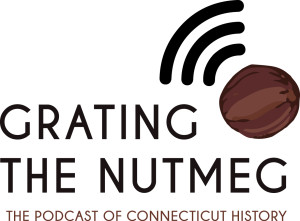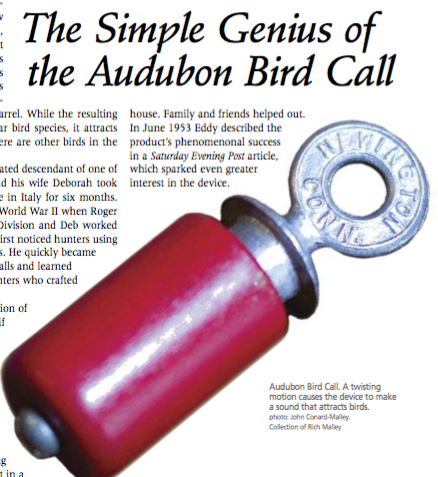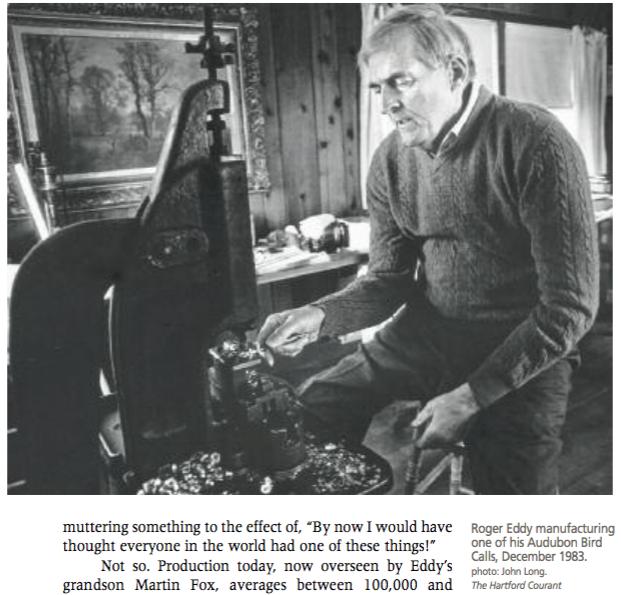By Richard C. Malley
(c) Connecticut Explored Inc. WINTER 2015/16
Listen to Rich demonstrate the bird call at Gratingthenutmeg.libsyn.com
Subscribe/Buy the Issue
A bird call may not be on everyone’s list of well-known Connecticut products, but perhaps it should be. Like most of the better-known manufactures on the list of Connecticut products, the Audubon Bird Call, invented by Connecticutan Roger Eddy in 1952, could be found on most continents, according to decades’ worth of sales records.
Where many Connecticut-made products have pushed the boundaries of technology, Eddy’s bird call embodied Connecticut genius in its simplicity. Birchwood, pewter (now replaced by a lead-free zinc alloy), a small screw, red paint, and a bit of pine rosin are all the materials needed to make and maintain this handy device. The call’s sound is produced by twisting the cast-metal plug against the wooden barrel. While the resulting sound does not mimic a particular bird species, it attracts birds by convincing them that there are other birds in the immediate area.
In 1951 Newington’s Roger Eddy, Yale-educated descendant of one of Connecticut’s earliest families, and his wife Deborah took their two young daughters to live in Italy for six months. The couple had met there during World War II when Roger served with the 10th Mountain Division and Deb worked for the Red Cross. It was here he first noticed hunters using small bird calls to attract songbirds. He quickly became fascinated with these small hand-held calls and learned as much as he could from the hunters who crafted and used them.
Returning home with a collection of Italian bird calls, Eddy wondered if the National Audubon Society (state organizations beginning in 1896 came together to form the national society in 1901; Connecticut founded a chapter in 1898) might be interested in a story about them for its magazine. While the Audubon Society was not interested in any story about hunting songbirds using bird calls, it did express an interest in a bird call for bird-watching purposes. Eddy developed a model he dubbed the Audubon Bird Call in honor of the national society.
Despite a slow start to the new business, during which Roger pounded the pavement across New England, Yankee-peddler-style, selling his invention to gift shops, pet shops, and sporting goods stores, within a year his deceptively simple call began to take off, with sales at times outpacing his ability to produce them. He subcontracted with others to manufacture the wood barrel and metal plug, but finishing and final assembly took place in the living room of his house. Family and friends helped out. In June 1953 Eddy described the product’s phenomenonal success in a Saturday Evening Post article, which sparked even greater interest in the device. In time a small paid staff of assemblers took some of the burden off Eddy’s family and friends..
Through the ensuing decades Audubon Bird Calls were produced in a workshop and office attached to a dairy barn on Eddy Farm. Kyle Conard, who worked for Eddy for more than 18 years, remembers filling bird call orders for distributors and individuals from Cape Cod to Amsterdam to Australia. At one point there were enough orders coming from France that a French version of the instruction sheet was developed. Conard recalls seeing Eddy, after a particularly busy holiday season, scratching his head and muttering something to the effect of, “By now I would have thought everyone in the world had one of these things!”
Not so. Production today, now overseen by Roger’s grandson Martin Fox, averages between 100,000 and 150,000 bird calls per year, and Fox estimates at least several million Audubon Bird Calls have been produced since its invention. Why has this product sold so well? Besides a relatively low retail price, there have been only a handful of serious competitors over the decades, now reduced to one, Toysmith, which markets a similar bird call specifically for children. The key to the Audubon Bird Call’s success is that it works as advertised. With only one moving part, it does what it claims it will do—attract birds.
Roger Eddy’s interest in birds also resulted in his manufacturing bird feeders that used two- and three-liter plastic soda bottles to hold the seed. These feeders gained wide popularity with bird lovers beginning in the 1980s, in part because they reused plastic soda bottles in the days before bottle deposits and recycling.
Meanwhile, Eddy was also running a farm that produced, at various times, milk, beef cattle, berries, apples, vegetables, maple syrup—and even a hardy variety of Mediterranean yew tree suitable for New England landscapers! Somehow, amidst all this, the aspiring writer in him found time to publish several novels and nonfiction pieces, serve in the Connecticut state house (1959 to 1961) and senate (1967 to 1971), become a regular on public-affairs TV programs, and run for U.S. Senate in 1986.
More than a decade after Eddy’s death in 2003 Fox continues production of the call, and although manufacturing now takes place in Rhode Island, the metal twisting ring still reads “NEWINGTON CONN.”
Rich Malley is an independent history and museum consultant in Connecticut.
Explore!
 Listen to a podcast about Roger Eddy’s Audubon Bird call at Gratingthenutmeg.libsyn.com–the podcast of Connecticut history brought to you by Connecticut Explored and the State Historian.
Listen to a podcast about Roger Eddy’s Audubon Bird call at Gratingthenutmeg.libsyn.com–the podcast of Connecticut history brought to you by Connecticut Explored and the State Historian.
Read more stories about products Made in Connecticut


